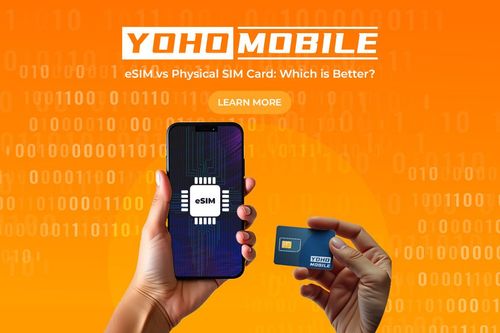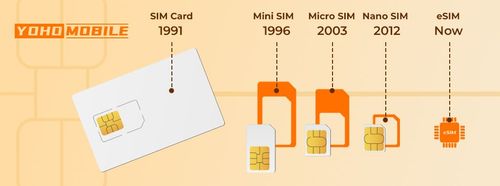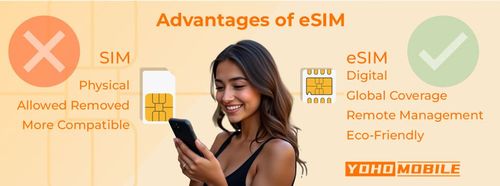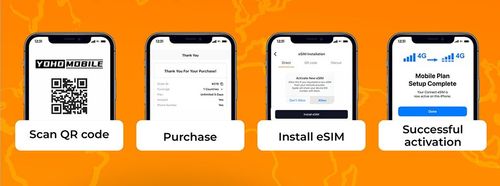eSIM vs physical SIM card: Which is better? Stick around as we break down the pros and cons of each, helping you decide which is the right choice for your mobile needs.

Related: eSIM vs Nano SIM: A Modern Traveler’s Dilemma
What is A SIM Card?
A SIM card (Subscriber Identity Module) is a small, removable chip in your phone that stores important information. It connects your phone to your mobile network, so you can make calls, send texts, and use data. The SIM card holds your phone number and other details needed to identify and authenticate you on the network.
There are three main types of SIM cards. Each type provides the same function but varies in size and form.
- Standard SIM: The largest type, used in older phones.
- Micro SIM: Smaller than the standard SIM, found in many smartphones from around 2010-2015.
- Nano SIM: The smallest physical SIM card, used in most modern devices.

What is An eSIM Card?
An eSIM (embedded SIM) is a small chip built into a device like a smartphone or tablet. eSIMs are activated digitally, unlike traditional SIM cards, which you have to physically insert into your device. This makes eSIMs more convenient and flexible since they’re easy to switch carriers or plans without needing a new physical card. eSIMs are supported by many modern devices and provide the same network performance as traditional SIM cards.
How Does an eSIM Work?
An eSIM acts like a physical SIM card but is built-in and can’t be removed. It stores your mobile network information digitally. Instead of inserting a physical card, you download a carrier’s profile using a QR code or app. This digital profile lets your phone connect to the mobile network, with no physical SIM card. It also makes switching carriers or cellular plans easier, as you can change your network settings remotely, store multiple profiles, and switch between them when needed.
What Are The Benefits of eSIM vs SIM Card?
eSIMs are a step toward the future, making mobile connections more efficient, flexible, and sustainable. Here are the top advantages of using an eSIM vs a physical SIM card.
Easy Switching
eSIMs make switching carriers easy. The eSIM is embedded in smartphones and rewritable. This means you can switch to a new carrier without waiting for a SIM card, messing with physical SIM slots, or relying on roaming fees or public Wi-Fi.
Multiple Profiles
With eSIM-compatible devices like the iPhone 14, you can have up to eight eSIMs, though only two can be active at a time. This flexibility is handy in areas with varying signal strengths.
Space Saver
eSIMs are tiny, even smaller than Nano SIMs. This small size allows for bigger batteries and more space for innovation in phones, like adding another chip, sensor, or a more powerful battery. They also make it easier to waterproof devices as eSIMs don’t have to be close to the phone’s edge.
Enhanced Security
eSIMs make it harder for thieves to evade tracking since they can’t be physically removed like physical SIMs. This added security layer helps locate lost devices and prevents SIM removal for tracking evasion. Although criminals may still try to reset the phone, the embedded eSIM provides more time to potentially find it.
Increased Durability
Having a chip fixed onto the motherboard reduces the chances of issues, making the device last longer.
Eco-Friendly
eSIMs are eco-friendly as they don’t use plastic cards or shipping materials. eSIMs help cut down on waste compared to traditional SIM cards, which often end up being thrown away.
IoT Compatibility
eSIMs have more benefits than just for phones. They’re perfect for laptops, tablets, smartwatches, fitness trackers, portable modems, IoT gadgets, and home security devices. Their tiny size fits designs where regular SIM cards wouldn’t work.
What Are The Downsides of Using An eSIM?
While eSIMs offer many benefits, several disadvantages affect their widespread adoption. Here are some key downsides to eSIM versus SIM cards to consider:
Limited Support
Not all carriers support eSIMs yet. Major carriers in the US do, but support varies by country. Smaller carriers might not offer eSIM services on popular phones like iPhones and Samsung Galaxy devices. Even if a phone has eSIM capability, it might not be available at all in certain regions or with specific carriers.
Switching Challenges
When changing phones with an eSIM, you need to install an app or enter instructions to deactivate the eSIM on the old device and activate it on the new one. This process, though generally easy, can be tricky if the new carrier doesn’t support eSIM or if the phone is locked to a specific carrier.
Troubleshooting Issues
Fixing eSIM connection problems is not always seamless and may require technical support or additional steps. For instance, if you have connectivity issues, you can’t just move the eSIM to another phone to test it like you can with a physical SIM.
What Are The Major Advantages of Physical SIM Cards?
A traditional physical SIM card has been the trusted technology for mobile connectivity for decades. Physical SIM cards continue to be a dependable and widely used option, although eSIMs are becoming more popular. Here are the main benefits of physical SIM vs eSIM:
Ease of Transfer
Your network information is stored on a physical chip, making it very easy to transfer between phones. Simply remove the SIM card from one device and insert it into another, and you’re good to go.
Universal Compatibility
Physical SIM cards offer the broadest compatibility with phones and networks. Whether you have an older phone model or the latest smartphone, chances are it will have a slot for a physical SIM card. This means you can use the same SIM card across a wide range of devices and carriers without any issues.
No Special Requirements
Physical SIM cards can be used in almost any mobile device, unlike eSIMs, which require specific hardware and software support. This means you don’t need to worry about your phone not supporting the latest technology; a physical SIM card will almost always be compatible.
Downsides of Physical SIMs
Risk of Damage or Loss
Physical SIM cards, though durable, can go bad or be lost. Replacing them is often a hassle and may incur extra costs. Also, losing a SIM card could cause a temporary loss of service.
Inconvenience in Network Switching
To switch networks with a physical SIM, you need to visit a local store, wait for a new card to be shipped, and open physical SIM slots. This is time-consuming compared to eSIMs, which can switch networks digitally.
Limited Storage Capacity
Physical SIM cards have limited storage for contacts and text messages. Modern phones may rely more on cloud storage, but the SIM’s limited capacity can still be a drawback for some users.
Compatibility Issues
Different devices may require different SIM card sizes (standard, micro, nano). If you switch devices, you might need a SIM card adapter or a new SIM card.
Environmental Impact
The process of making and distributing physical SIM cards has a huge environmental impact. It involves plastic and other materials, which leads to a larger carbon footprint.
Security Risks
Physical SIM cards can be stolen or cloned. In contrast, eSIMs offer better protection against theft and fraud since they are embedded in the device and harder to tamper with.
Comparison Chart: eSIM vs Physical SIM Card
| Feature | eSIM | Physical SIM |
|---|---|---|
| Support | Major carriers support eSIMs, growing availability | Widely supported across all carriers and regions |
| Signal Strength | Same as physical SIM cards. | Signal strength depends on carrier and device, not SIM type |
| Network Switching | Instant switch networks without visiting stores | Requires physical card swap and often a store visit |
| Ease of Transfer | Digital transfer without physical handling | Simple physical swap between devices |
| Security | Hard to tamper with or steal | Can be stolen or cloned |
| Risk of Damage/Loss | Embedded in the device, no physical damage | Can go bad or be lost easily |
| Storage Capacity | No storage limitations | Limited storage for contacts/messages |
| Activation Process | Can be activated quickly and easily online | Often requires store visit or waiting for SIM card delivery |
| Troubleshooting | May require technical support | Easily tested by moving SIM to another device |
| Cost | Lower costs, no need for manufacturing/shipping | May involve costs for manufacturing, shipping, and replacement |
| Environmental Impact | Lower, no physical waste | Higher plastic waste and carbon footprint |
Is An eSIM Better Than A Physical SIM card?
Yes, an eSIM is a great upgrade from traditional SIM cards. With an eSIM, you don’t have to worry about getting a physical SIM card sent to you as they’re built into your device. eSIMs are more flexible since you can have multiple data plans for different countries on a single device. Also, since eSIMs don’t take up physical space, your device can be slimmer and more durable.
While not all devices and carriers support eSIMs yet, many are starting to adopt this technology. Using an eSIM can make your life easier, giving you more control over your mobile service.

If you’re looking for a smarter, more convenient way to manage your phone, eSIMs are the way to go.
How to Install and Activate An eSIM
Before getting started with an eSIM, it’s advisable to double-check If your device is eSIM-compatible and carrier-unlocked. Also, be sure to have the QR Code printed or on another device, and you have stable internet from start to finish. Once you check them all, then go ahead and follow these guidelines:
-
Install the eSIM: Follow the on-screen instructions to add the eSIM to your device. Install your eSIM a day before your trip and activate it during your flight or upon arrival.
- Install via QR code if you have the code on another device. Opt for manual installation if you can’t scan the QR code.
- Select the device on which you are going to install an eSIM (iPhone, Samsung, Google Pixel) and follow the instructions for each device, if you face problems during the process, contact the support team.
-
Activate the eSIM: Once installed, activate the eSIM in your phone’s settings.
-
Enjoy seamless connectivity!

🎁 Special Discount for Our Readers!
As a special treat for our readers, Yoho Mobile is offering an exclusive discount! Use our coupon code “YOHOREADERSAVE” to get your first order for FREE!
Don’t miss out on this opportunity to stay connected affordably while traveling.
FAQs on eSIM vs Physical SIM Card
What’s the Difference Between eSIM and SIM Card?
A SIM (Subscriber Identity Module) card is a small physical chip inserted into a phone for mobile network access while an eSIM (embedded SIM card) is a built-in digital version. With eSIM, users can switch carriers without swapping phones or SIM cards. Also, eSIMs reduce plastic waste and are more convenient and flexible than traditional SIM cards.
Are eSIMs Safe?
Yes, eSIMs are safe. They use advanced encryption to protect your data, just like physical SIM cards. eSIMs are embedded directly into your device, so they have a lower risk of physical tampering. In fact, they are managed remotely by your service provider, which can quickly address any security concerns.
Does eSIM Have Better Signal Than SIM Card?
No, eSIMs and physical SIM cards generally have the same signal quality. The signal strength depends on the network coverage of your mobile service provider, not the type of SIM card. Both eSIMs and SIM cards connect to the same cellular networks, so their signal performance is essentially identical.
Should I Convert to eSIM?
Yes, switching to eSIM is a smart choice. An eSIM is like a virtual SIM card that is already inside your phone, so you can change carriers and data plans without a physical card. This makes traveling easier, as you can quickly switch to a local network. eSIMs are also eco-friendly and help reduce plastic waste. If you value flexibility and sustainability, choosing an eSIM is a great option.
Can You Have a Physical SIM Card and eSIM?
Yes, you can use both a physical SIM card and an eSIM at the same time on many modern smartphones. This allows you to have two phone numbers or data plans on one device. It helps manage work and personal lines when traveling, as you can keep your home number active while using a local data plan.
